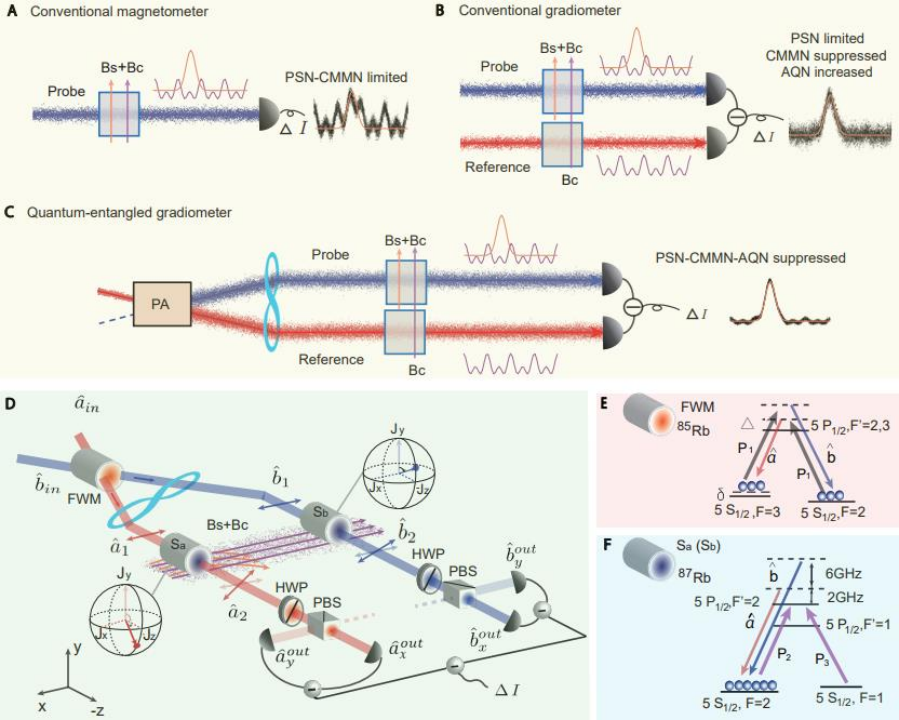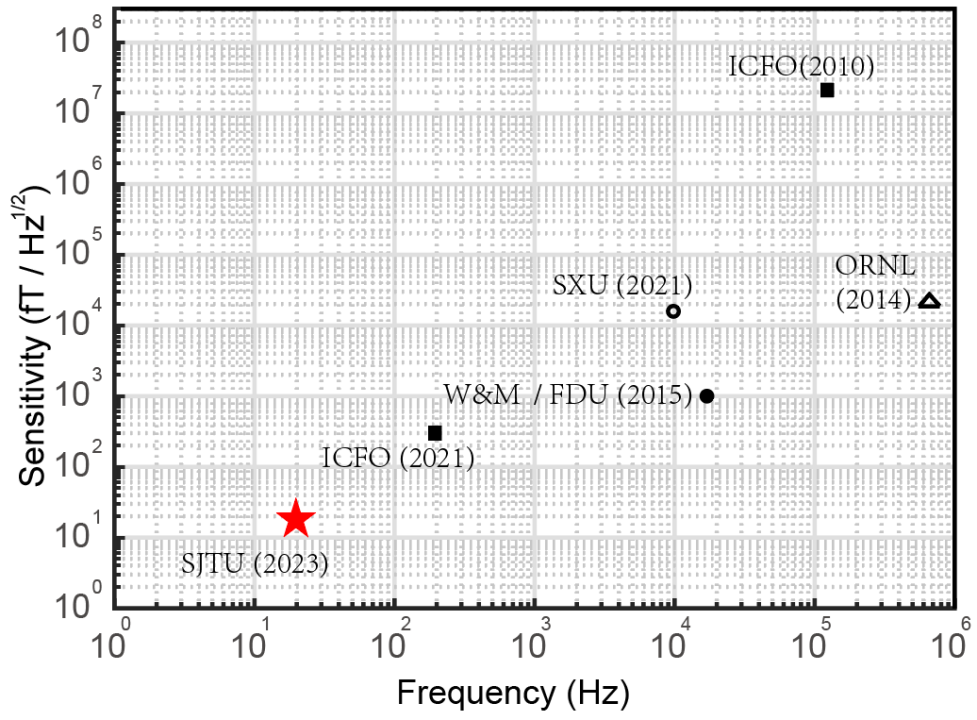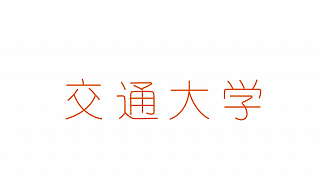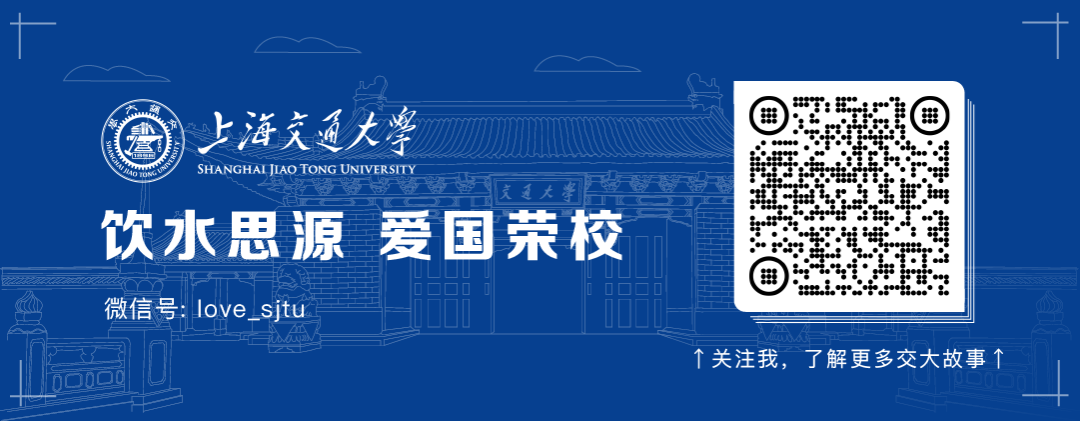


The team led by Professor Zhang Weiping from the School of Physics and Astronomy at Shanghai Jiao Tong University and the C.N. Yang Institute has made significant progress in the field of quantum precision measurement. This team has integrated the relevant quantum optical technologies developed based on a light-atom hybrid system with traditional magnetometers, achieving a quantum-enhanced atomic magnetic field gradient meter applicable in low-frequency bands under real noise environments.
This research addresses the challenges posed by geomagnetic and noisy magnetic field environments, breaking through the limitations of the standard quantum limit for magnetic field measurement, and setting a new record for the sensitivity of similar magnetometers internationally. It is expected to demonstrate quantum advantages in heart and brain magnetic measurements, opening new avenues for practical quantum technology.
The related research results were recently published in the Science journal under the title “Quantum Magnetic Gradiometer with Entangled Twin Light Beams” in Science Advances.
In recent years, research and development in quantum precision measurement have surged, particularly in atomic magnetometers based on light-atom interactions, which are noted for their high sensitivity and ease of miniaturization. However, environmental magnetic field noise, optical detection quantum noise, and spin projection noise have been major bottlenecks limiting the performance enhancement and application expansion of atomic magnetometers.
According to quantum optical theory, optical detection quantum noise and spin projection noise depend on the number of photons and atoms in the system sensitive to the magnetic field, respectively. The quantities of both limit the sensitivity of magnetic field measurements, known as the standard quantum limit. The highest sensitivity traditional atomic magnetometer—the spin exchange relaxation free (SERF) magnetometer—achieves high sensitivity by increasing the operating temperature of the atomic pool (usually around 120°C) to increase the number of atoms. However, excessively high operating temperatures limit its applications in biomedical fields. At room temperature, the number of atoms is low, and to achieve sensitivity levels comparable to SERF magnetometers, it is necessary to break through the constraints of the standard quantum limit, which is a challenge that scientists in this field are focusing on internationally.
This published work represents a significant breakthrough in overcoming these limitations by developing quantum technology, addressing the limitations of magnetometers in practical applications. The research team proposed to cleverly combine the advantages of quantum optical fields and magnetic field gradient meters using twin beam detection methods, which simultaneously suppress optical field detection quantum noise and eliminate common-mode magnetic field noise in real environments.

Scheme and principle diagram of the quantum entangled gradient meter
The researchers injected the dual-mode squeezed field generated during four-wave mixing (FWM) into a dual-probe magnetic field gradient meter based on nonlinear magnetic optical rotation (NMOR), allowing for quantum correlation in dual-probe measurements. In experiments, a 5.5 dB reduction in the noise power spectrum of the magnetometer was observed, marking the largest quantum enhancement observed in magnetometers; the quantum-enhanced frequency ranged from 7 Hz to 6 MHz, covering the frequency range of heart and brain magnetism; the common-mode suppression ratio of the gradient meter reached 5000, meeting practical application requirements; ultimately achieving the best sensitivity for magnetic field measurement at 18 fT/cm at 20 Hz, marking the first observation of quantum enhancement effects in magnetic field measurement below 10 Hz internationally. This opens new avenues for the application of atomic magnetometers in biomedical fields.

International progress in research on compressed light magnetometers
This work received high praise from reviewers, “I really enjoyed reading this carefully prepared and well-written manuscript describing a beautiful and novel piece of work (I really enjoyed reading this carefully prepared and well-written manuscript describing a beautiful and novel piece of work)”, and pointed out “There is a lot of hype around quantum squeezing and entanglement, but very few practical applications. This work convincingly delivers such a case—an atomic magnetic field gradient meter under quantum enhancement (While there is a lot of hype around squeezing and entanglement, there are very few applications of practical use. This work convincingly delivers such a case, that of atomic magnetic gradiometry)”, “The authors elegantly use a vapor cell with Rb-85 to generate twin (entangled) beams and use them for magnetometry with two separate cells of Rb-87 to show a sizable improvement in sensitivity (The authors elegantly use a vapor cell with Rb-85 to generate twin (entangled) beams and use them for magnetometry with two separate cells of Rb-87 to show a sizable improvement in sensitivity)”.
Postdoctoral researcher Bao Gu Zhi, Professor Zhang Weiping from Shanghai Jiao Tong University, and Professor Chen Liqing from East China Normal University are co-corresponding authors. Doctoral student Wu Shu He from Shanghai Jiao Tong University is the first author of the article. This work was supported by the Ministry of Science and Technology, the National Natural Science Foundation, the Shanghai Municipal Science and Technology Commission, the Development and Reform Commission, and the China Postdoctoral Fund.
Paper Information
Shuhe Wu et al., Quantum magnetic gradiometer with entangled twin light beams. Sci. Adv. 9, eadg1760(2023).
https://doi.org/10.1126/sciadv.adg1760




Recommended Reading
1、National recognition, many from Jiao Tong University selected!
2、The first high-temperature superconducting electric levitation vehicle is here!
3、Latest results! Jiao Tong University wisdom helps discover new evidence of ancient liquid water on Mars
4、Questioning the heavens, this is the “cosmic-level” romance of Jiao Tong University people
5、Breaking historical records!

Jiao Tong University Wisdom!
